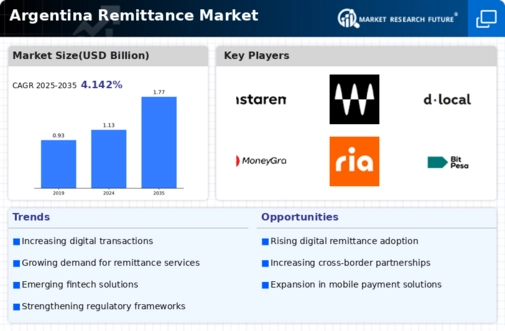Regulatory Framework Enhancements
The remittance market in Argentina is shaped by ongoing enhancements in the regulatory framework. The government is actively working to create a more conducive environment for remittance services, which includes simplifying compliance requirements and reducing transaction costs. Recent reforms aim to increase transparency and protect consumers, which may lead to a more trustworthy market. As of November 2025, the regulatory landscape appears to be evolving, with new guidelines expected to be implemented that could facilitate easier access to remittance services for both senders and receivers. This proactive approach by authorities may encourage more players to enter the market, thereby increasing competition and potentially lowering fees for consumers. Such developments are likely to have a lasting impact on the remittance market.
Increased Financial Inclusion Initiatives
The remittance market in Argentina is benefiting from increased financial inclusion initiatives aimed at expanding access to financial services. The government and various organizations are working to integrate unbanked populations into the financial system, which is expected to enhance the remittance landscape. By 2025, initiatives such as mobile banking and community-based financial services are projected to reach millions of individuals who previously lacked access. This expansion is likely to create new opportunities for remittance service providers, as more people will be able to send and receive funds through formal channels. The emphasis on financial literacy and education may further empower individuals to utilize remittance services effectively, thereby contributing to the growth of the remittance market.
Economic Stability and Currency Fluctuations
The remittance market in Argentina is closely tied to the country's economic stability and currency fluctuations. As the Argentine peso experiences volatility, the value of remittances can be significantly affected. In 2025, the exchange rate is projected to fluctuate, which may influence the amount received by beneficiaries. Economic stability is crucial for maintaining a favorable environment for remittance flows, as it impacts both the sending and receiving sides of transactions. A stable economy could lead to increased remittance volumes, while instability may deter potential senders. Consequently, the remittance market is likely to reflect these economic conditions, with service providers needing to adapt their strategies to navigate the challenges posed by currency fluctuations.
Growing Demand for Cross-Border Transactions
The remittance market in Argentina is significantly influenced by the growing demand for cross-border transactions. With a large diaspora, particularly in countries like Spain and Italy, the need for efficient remittance services is paramount. In 2025, remittances to Argentina are projected to reach approximately $3 billion, highlighting the importance of this market segment. This demand is driven by factors such as family support and investment opportunities, prompting service providers to enhance their offerings. As competition intensifies, companies are likely to innovate and reduce fees, which could further stimulate growth in the remittance market. The increasing reliance on remittances for household income underscores the critical role this market plays in the Argentine economy.
Technological Advancements in Payment Systems
The remittance market in Argentina is experiencing a notable transformation due to technological advancements in payment systems. Innovations such as mobile wallets and blockchain technology are streamlining the transfer process, making it faster and more cost-effective. In 2025, it is estimated that over 60% of remittances are processed through digital channels, reflecting a shift from traditional methods. This trend not only enhances user experience but also increases accessibility for individuals in rural areas. As more Argentinians embrace digital solutions, the remittance market is likely to expand, attracting new players and fostering competition. The integration of advanced security measures further instills confidence among users, potentially leading to increased transaction volumes and a more robust market overall.

















Leave a Comment